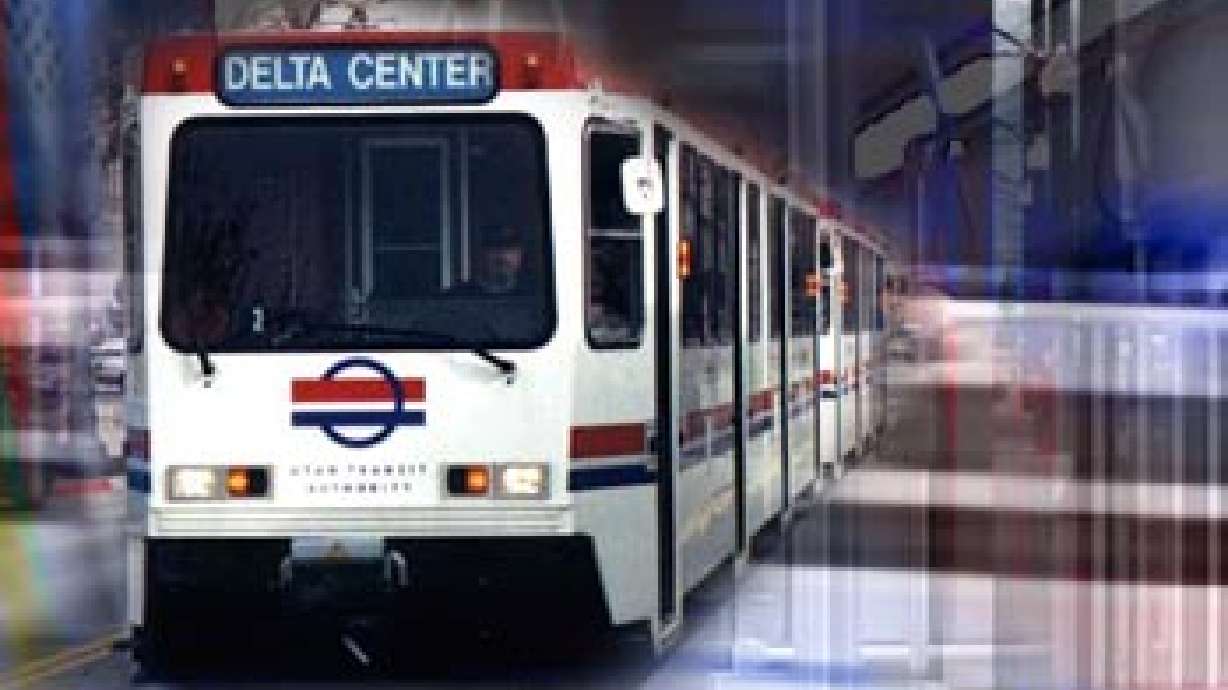Estimated read time: 5-6 minutes
This archived news story is available only for your personal, non-commercial use. Information in the story may be outdated or superseded by additional information. Reading or replaying the story in its archived form does not constitute a republication of the story.
SOUTH SALT LAKE, Utah (AP) -- Just before the TRAX trains whiz past, the wires crinkle and buzz above. That's a warning to Kim Martinez to raise her hand to the train conductor as an "I see you, you see me" greeting.
Martinez waves for a few seconds, then turns back to the task at hand -- a 2,500-square-foot mural covering the side of a construction supplies building in South Salt Lake. She and her dozen art students from the University of Utah have been painting the wall faithfully -- rain, heat or cold -- since September and hope to finish within the next three weeks.
The mural, on the east side of Standard Builders Supplies at roughly 2700 South along the TRAX lines, shows a mass of railroad tracks winding between two large workers, who join the rails at the center of the mural as a symbol of the Golden Spike -- the name of the mural. The ubiquitous Wasatch mountains, Great Salt Lake, and Salt Lake City are in the background. The design harks to the Roper rail yards in South Salt Lake and the city's blue-collar tradition.
But, more than the art, the mural is about the community's involvement. More than a dozen people have spent weeks creating the mural, and thousands see it each day as their trains rush past.
"The only way you can see these is going 50 miles per hour," Martinez said. "You have to be on TRAX to see this. Who rides this train? It's everyone from Salt Lake City to Sandy."
The painting is exhausting for the students. They spend about seven hours each Friday on the scaffolding. In September's heat, they baked in the reflection off the still white, unpainted wall. During October weekend storms, they wore trash bags and tried to prevent the water-based paint from running. Now in late November, they're bundled up in layers and trying to keep paint-covered fingers from freezing.
"The weather makes it a lot harder, and it's exhausting," student Carlos Perez said. "But I'm enjoying being a part of it."
In two previous mural-painting classes, Martinez allowed the students to choose their own murals. This time, however, she wanted to challenge them with her own creation, so she did the model painting over the summer. When the class found a site for the painting, she stretched her design to the building's dimensions. After the class applied 20 gallons of thick primer, the students painted a grid on the blank wall with 1-foot squares. Next, they drew on Martinez's design with chalk lines, and firmed up the chalk lines with spray paint. They followed up with a base coat of violet and then the outer layers of paint.
Martinez is teaching her students a glaze painting technique, applying thin layers of paint over base colors that will add depth to the final product. The result of the glaze is a brown skin that is really five different shades of browns, blues and violet. Corners of the mural still have the vibrant violet showing. Eventually, a student in a boom truck will paint over it to match the cerulean sky and wispy clouds.
"You put a color down, but ultimately you don't know what color it's going to be until you put the next color on it," Martinez said.
Translating the painting from a 3-foot canvas to a wall hundreds of times that large hasn't been smooth. The process requires constant adjusting.
"This looks great at this size, but once you get it up there, everything changes," Martinez said, which is why she directs students from below the scaffolding as they scramble between the metal planks and poles. "As you come up here, you lose the whole painting."
Student Barbara Jerome said she has seen people peeking over fences to look at the wall. Jerome won a contest earlier this fall for a future mural design depicting Utah's prehistoric heritage through cliff dwellings in the southern part of the state all the way through modern Salt Lake City. Her mural may be among those Martinez's future classes paint.
"I think it would be very cool to see your own painting on the side of a huge building," Jerome said. She hopes that UTA will consider a dedicated tour of the murals along the line for school field trips.
Standard Builder Supplies owner Mike Hansen said the project has been nothing but good news for his company and employees; it also seems to be subduing graffiti on neighboring buildings.
"I like the artistry of it," Hansen said. "It's been nice to enable those kids to have a place to do it. They've been very polite and we've been accommodating so it's worked out very nicely for all of us."
UTA and South Salt Lake split the cost of the TRAX beautification project. The paint, about 30 gallons for the whole semester, scaffolding, truck rental and supervision by a South Salt Lake official costs about $5,000 per mural. The grants also pay for a trip for the class to fine art galleries in New York or Los Angeles as a way of compensating students for their work. "We can't give them a wage, but many of them haven't been to New York," Martinez said. "It's an investment in their educations."
The building owners who host the murals agree to leave them for at least five years, and the class hopes to apply an anti-graffiti glaze over the finished mural, which would allow workers to rinse off vandals' marks. South Salt Lake is home to eight murals, including Martinez's current project, and Salt Lake City has one. Other TRAX stations have sculptures, paintings or signs sponsored with the same source of money from UTA that helped pay for the most recent mural.
(Copyright 2005 by The Associated Press. All Rights Reserved.)









